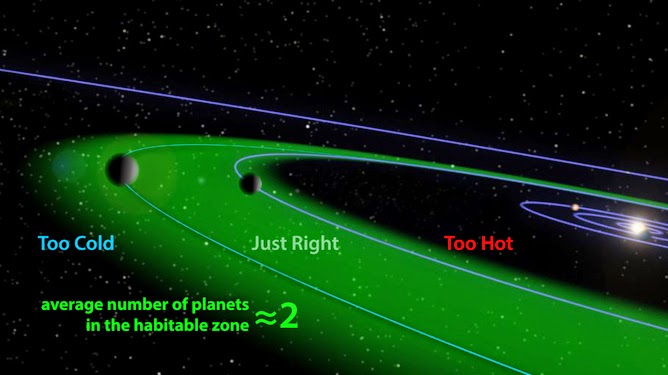With about 300 billion stars in our galaxy, researchers analyzing Kepler data and modified theory calculate there are 600 ± 300 billion planets in circumstellar habitable zones in our galaxy.
In the observable universe there are about 100 billion galaxies. Thus there are approximately 10^22 stars in the observable universe and twice that many planets in circumstellar habitable zones in the universe.
That’s a lot of real estate for alien development. Not all of these habitable zone planets will be wet and rocky like the Earth, but a fair fraction (about 30%) should be. Now we need some zippy interstellar spaceships to colonise and over-populate all these worlds before the aliens do.
The Goldilocks zone or habitable zone around a star is where the temperature is just right to have liquid water. Our new result suggests that there are, on average, two planets in the habitable zone. Aditya Chopra, ANU, adapted from NASA/JPL
Monthly Notices of the Royal Astronomical Society- Using the inclinations of Kepler systems to prioritize new Titius–Bode-based exoplanet predictions
Nextbigfuture covered this paper two weeks ago. This new look is applying the results of a prediction tripling the estimate of habitable zone exoplanets to galactic and universal estimations.
Read more »![]()
In the observable universe there are about 100 billion galaxies. Thus there are approximately 10^22 stars in the observable universe and twice that many planets in circumstellar habitable zones in the universe.
That’s a lot of real estate for alien development. Not all of these habitable zone planets will be wet and rocky like the Earth, but a fair fraction (about 30%) should be. Now we need some zippy interstellar spaceships to colonise and over-populate all these worlds before the aliens do.
The Goldilocks zone or habitable zone around a star is where the temperature is just right to have liquid water. Our new result suggests that there are, on average, two planets in the habitable zone. Aditya Chopra, ANU, adapted from NASA/JPL
Monthly Notices of the Royal Astronomical Society- Using the inclinations of Kepler systems to prioritize new Titius–Bode-based exoplanet predictions
Nextbigfuture covered this paper two weeks ago. This new look is applying the results of a prediction tripling the estimate of habitable zone exoplanets to galactic and universal estimations.
Read more »
